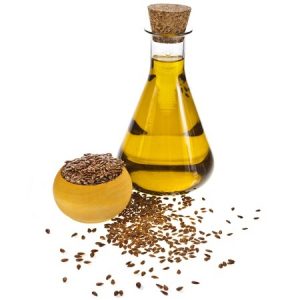
♦ Flaxseeds contain a range of active components which could reduce the disease factors associated with Metabolic Syndrome (MS) as well as help ameliorate cardiovascular disease, cancer and atherosclerosis.
♦ Flaxseed oil is a fine source of omega-3 fatty acids as well as omega-6 and omega-9 fatty acids.
♦ It is believed to contribute to heart health and help reduce inflammation.
Overview
Flaxseed or linseed (Linum usitatissimum) has long been in cultivation, having been grown in the Near East from 9,000 BCE. Historically and to the present day, flax has been turned into linen and it’s most common function in the diet was as an ingredient in bread, and to serve as a laxative. Canada is now the largest grower, generating 2 billion tons annum (Hall et al., 2006). When we consider this seed it is best to look at it in two parts, the seed itself containing a raft of important compounds and the oil which is used not only as a supplement but in industrial applications.
The oil is an important paint-drying agent and varnish and has also been consumed for its heart health and inflammation benefits, whilst the protein is used in bar and beverage formulations.
The Seeds
Flaxseed is now a significant functional food which as a seed could counter many of the aspects associated with metabolic syndrome (MS). The seed is a great source of biologically active compounds such as dietary fibres, plant proteins, various polyunsaturated fatty acids (PUFAs) and lignans. All these have been associated with functional benefits to the point of preventing certain specific diseases (Rubilar et al., 2010; Taylor et al., 2010; Kajla et al., 2015).
The seed contains non-starch polysaccharide or soluble fibre, and the flax lignan complex (FLC) (Prasad, 2009). Its main lignan is secoisolariciresinal diglucoside (SDG) (approx. 1%w/a dry weight) with a level of up to 1.8g/100g seed (Khalesi et al., 2011). Other lignans include pinoresinol, cinnamic acid glucoside, lariciresinol, matairesinal, and hydroxymethylglutaryic acid.
The lignin, SDG is degraded throughout the intestines to secoisolariciesinol, enterodiol (ED), and enterolactone (EL). These have health benefits too although surprisingly less defined (Hu et al., 2007; Zhang et al., 2008).
The soluble and insoluble fibre componentry is mainly 6%w/w dry weight (Bloeden and Szapary, 2004). The soluble fibre forms the mucilage of the seed and comprises 25% of the total dietary fibre in the seed.
Phytoestrogens which have important benefits have also been isolated from the seed.

Flaxseed Oil
Flaxseed oil is a commercially important vegetarian source of the polyunsaturated fatty acids (PUFAs), mainly omega-3 fatty acids (50 to 60%) and mostly alpha-linolenic acid at that, and then smaller amounts of omega-6 and omega-9 fatty acids.
The oil is one of the richest sources of alpha-linolenic acid (ALA, C18:3 ω-3) known forming up to 57% of the oil content, although 62% has been notified, and 20%w/w dry weight of the seed.
Biochemical processes for producing eicosapentaenoic acid and docosahexaenoic acid use ALA as the starting fatty acid in the pathway. The two synthesisied fatty acids are key for reducing the risk of various chronic diseases such as cardiovascular disease, atherosclerosis, cancer and hyperlipdemia (Rodriguez-Leyva et al., 2010).
The remaining oil is mostly linolenic acid (LA, ω-6) comprising 15 to 18%w/w. The PUFA composition depends on the growing conditions at the time.
Dieticians use it as a low-saturated fat ingredient because it contains 73% PUFA, 18% MUFA (mono-unsaturated fatty acids) and 9% saturated fatty acids (Malinowski and Gehret, 2010). These fatty acids are chemically different from those in fish so provide a slightly different and varied composition to the diet.
Flaxseed oil is now a component in some cosmetic face creams which are relying on the antioxidant and emollient properties of the oil. It appears to be a recent innovation.
Flaxseed Protein
Flax seed protein is not that common in the market place but like pea has many nutritional besides useful functional benefits for the product developer. Glanbia Nutritionals offer LinPro™140 which has a 38 to 40% w/w protein content, some omega-3 fatty acids and fibre (32%w/w). It has a Protein Digestibility Corrected Amino Acid Score (PDCAAS) of 0.68. This offers multiple benefits because it is not allergenic and could be used in bar products or beverages because it is relatively soluble albeit slightly hazy when in solution.
Key Clinical Studies On Flaxseed
There is a very comprehensive review available that covers the studies to date on the health benefits of flaxseed (Rodriguez-Leyva et al., 2010). The most recent study called FlaxPAD from the group at St Boniface Hospital Research Centre in Winnipeg, Manitoba, Canada (Rodriguez et al., 2012) looked at the effects of dietary flaxseed on hypertension, especially diastolic and systolic blood pressure in patients with peripheral artery disease (PAD). The clinical study on 110 patents over 40 years old with PAD, was single centre, prospective, double-blind and randomised. Each subject received 30g of milled flaxseed or a placebo every day for 6 months. Measurement of systolic blood pressure was 10mm Hg lower and that of diastolic blood pressure, 8 mm Hg lower in those taking the flaxseed compared to the placebo group. The group reinforce the view that dietary flaxseed is “an appealing strategy for treating hypertension in economically disadvantaged populations.”
A number of studies show that flaxseed reduces oxidative damage especially in those of us suffering Metabolic Syndrome (Pilar et al., 2014; Zuravski et al., 2015). It may be the case that the benefit here is due to oil, especially its high ALA contant (Karaka and Eraslan, 2013; Badawy et al., 2015). Some suggest its due to the lignin SDG (Hu et al., 2007; Newary and Abdou, 2009) and in a recent study with rats suffering oxidative stress, it is this component which is key (Pilar et al., 2017).
There is gathering evidence that the lignans are also involved in protection against cancers, especially ones that occur as a result of hormone imbalances. Activity against breast cancer is thought to occur because exposure to lignans in adolescence has been shown to help. The survival of breast cancer patients is also claimed to rise. The lignans may block enzymes that produce hormones and interfere with growth and the spread of cancer cells.
On a final health note, taking a tablespoon of ground up flaxseeds (about a teaspoon) is good for alleviating constipation.
Products
Please note this article contains links to our affiliate partner. Please read our affiliate disclosure.
Legal Disclaimer Concerning Products On This Web-Site
The products and the information provided about specific products on or through this site have not been evaluated by the United States Food and Drug Administration or by any other national regulatory body and are not intended to diagnose, treat, cure or prevent disease. The information provided on this site is for informational purposes only and is not intended as a substitute for advice from your physician/doctor or other health care professional or any information contained on or in any product label or packaging. You should not use the information on this site for diagnosis or treatment of any health problems or for prescription of any medication or other treatment. You should consult with a healthcare professional before starting any diet, exercise or supplementation program, before taking any medication or if you suspect you might have a health problem.
References
Bloedon, L.T., Szapary, P.O. (2004) Flaxseed and cardiovascular risk. Nutr. Rev., 62(1) pp. 18-27.
Hall, C. III., Tulbek, M.C., Xu, Y. (2006) Flaxseed. Adv. Food Nutr. Res, 51 pp. 1-97
, , . (2007) Antioxidant activities of the flaxseed lignan secoisolariciresinol diglucoside, its aglycone secoisolariciresinol and the mammalian lignans enterodiol and enterolactone in vitro. Food Chem. Toxicol. 45 pp. 2219–27.
, , . (2015) Flaxseed – a potencial functional food source. J. Food Sci. Technol. 52 pp. 1857–71
, , . (2011) Effect of raw and heated flaxseed (Linum usitatissimum L.) on blood lipid profiles in rats. Intl. J. Appl. Sci. Technol. 1 pp. 84–9.
Malinowski, J.M., Gehret, M.M. (2010) Phytosterols for dyslipidemia. Am J Health Syst Pharm, 67(14): pp. 1165-73
Pilar, B., Güllich, A., Oliveira, P., Ströher, D., Piccoli, J. and Manfredini, V. (2017) Protective Role of Flaxseed Oil and Flaxseed Lignan Secoisolariciresinol Diglucoside Against Oxidative Stress in Rats with Metabolic Syndrome. Journal of Food Science. doi:10.1111/1750-3841.13964
, , , , , , , , . (2014) 28-days dietary supplementation with golden flaxseed improves biochemical and oxidative parameters in patients with metabolic syndrome. J. Funct. Foods 10 pp. 232–42.
Prasad, K. (2009) Flaxseed and cardiovascular health. J Cardiovasc Pharmacol, 54(5): pp. 369-77.
Rodriguez, D., Weighell, W., Edel, A., La Vallee, R., Aliani, M., Guzman, R. Pierce, G. (2012) Abstract 12080: Potent Anti-Hypertensive Actions of Dietary Flaxseed in Patients With Peripheral Arterial Disease in The Flaxpad Trial. Session Title: Vascular Medicine (Noncoronary): Clinical Insights and Quality Outcomes. Circulation 126, A12080
Rodriguez-Leyva, D., Bassett, CMC., McCullough, R., Pierce, G.N. (2010) The Cardiovascular Effects Of Flaxseed And Its Omega-3 fatty Acid, Alpha-Linoleic Acid. Can. J. Cardiology. 26(9) pp. 489-496
, , , , . (2010) Flaxseed as a source of functional ingredientes. J. Soil Sci. Plant Nutr. 10 pp. 373–7
, , , , . (2010) Dietary milled flaxseed and flaxseed oil improve N-3 fatty acid status and do not affect glycemic control in individuals with well-controlled type 2 diabetes. J. Am. Coll. Nutr. 29 pp. 72–80
, , , , , , . (2008) Dietary flaxseed lignan extract lowers plasma cholesterol and glucose concentrations in hypercholesterolaemic subjects. Br. J. Nutr. 99 pp. 1301–9
, , , , , , , , , , . (2015) protective role of golden flaxseed (Linum usitatissimum L.) against oxidative damage in lipids and proteins of healthy volunteers. J. Biosci. Med. 3 pp. 45–53.


Leave a Reply